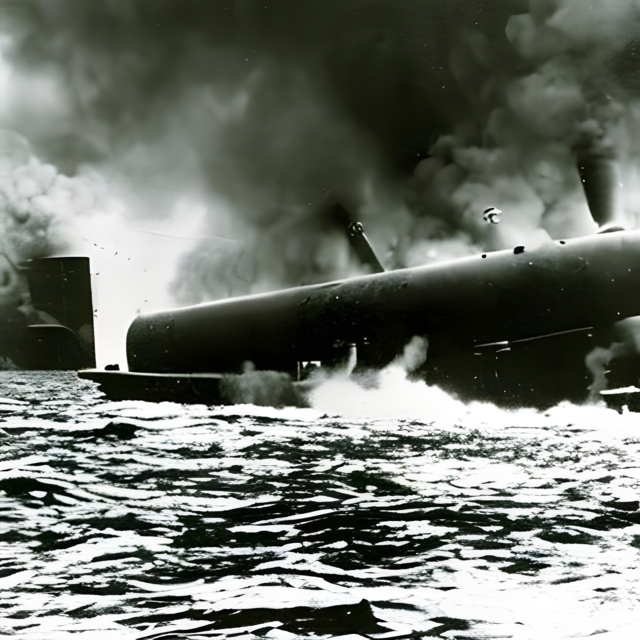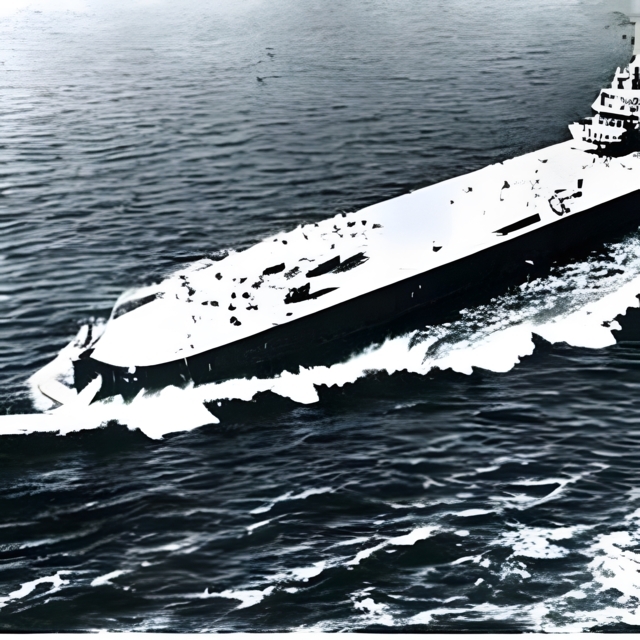World War II was a global conflict that affected millions of lives in different ways. Some countries were directly involved in the war, while others were indirectly affected by its consequences. Brazil was one of the latter, as it initially declared itself neutral but later joined the Allies in 1943 after a series of attacks by German submarines on Brazilian merchant ships. One of these attacks was the sinking of the Bage, a cargo liner that was carrying passengers and goods from Belem to Santos. This event, which occurred on August 1, 1943, was one of the most tragic and dramatic episodes of Brazil’s participation in the war, but it has been largely forgotten by history.
The Bage: A Ship with a History
The Bage was not originally a Brazilian ship. It was built in 1912 in Germany as the Sierra Nevada, a steamship owned by the Norddeutscher Lloyd company. It was used for passenger and cargo transportation between Europe and South America, mainly to Buenos Aires, Rio de Janeiro and Montevideo. In 1917, during World War I, the ship was interned at Recife, Brazil, and shortly thereafter seized by the Brazilian government and renamed Bage. It became part of the Lloyd Brasileiro company, which operated it on various routes until 1942.
The Bage was a large and comfortable ship, with a capacity for 129 passengers and 102 crew members. It had a tonnage of 8,235 tons and a length of 137 meters. It was equipped with wireless telegraphy and electric lighting. It had four decks and several cabins, saloons, dining rooms and lounges for the passengers. It also had a cargo hold that could carry up to 4,775 tons of goods, including rubber, fiber, cashew nuts, leather and cotton.
The Attack: A Night of Horror
On July 31, 1943, the Bage left Belem as part of convoy TJ-2, escorted by two Brazilian warships: the cruiser Rio Grande do Sul and the destroyer Marcilio Dias. The convoy was heading south along the Brazilian coast, with stops at Fortaleza, Recife, Bahia and Rio de Janeiro before reaching Santos. The Bage was carrying 129 passengers and 102 crew members, as well as a valuable cargo of rubber and other products.
However, the convoy was being tracked by a German submarine, U-185, commanded by August Maus. The U-boat had left Bordeaux on June 22 and had already sunk several Allied ships in the South Atlantic. On August 1, at around midnight, U-185 spotted the convoy and decided to attack it.
The first target was the Bage, which was sailing at the rear of the convoy. The U-boat fired a torpedo that hit the ship on the port side, causing a huge explosion and a fire. The ship began to sink rapidly, while panic ensued among the passengers and crew. Many people jumped into the water or tried to reach the lifeboats, but some were trapped inside or killed by the blast or the flames.
The U-boat then surfaced and opened fire with its deck gun on the sinking ship and on the survivors in the water. The attack lasted for about an hour, until U-185 submerged again and left the scene.
The other ships in the convoy did not realize what had happened until it was too late. The Rio Grande do Sul had ordered the Bage to leave the convoy earlier because it was making too much smoke and could attract enemy attention. The cruiser then increased its speed and lost contact with the rest of the convoy. The Marcilio Dias tried to locate the Bage but could not find it in the dark. It also failed to detect any radio signals from the ship or from U-185.
The result was a massacre. Out of the 231 people aboard the Bage, only 106 survived. Among them were 87 crew members and 19 passengers. They were rescued by fishing boats or reached land in their lifeboats after several hours or days at sea. Some of them suffered from burns, wounds or shark attacks.
Among those who perished were Arthur Monteiro Guimarães, the captain of the Bage; José de Almeida Pinto Júnior, a Brazilian diplomat who had been consul-general in Hamburg; José Maria de Souza Dantas Filho, a Brazilian journalist who had been correspondent for O Estado de S.Paulo in Berlin; João Batista Luzardo da Silva Pinto Coelho de Albuquerque e Melo e Cunha Guedes de Queiroz e Menezes de Drummond e Alvim de Noronha e Sousa e Sá e Benevides e Meneses e Carvalho e Albuquerque e Melo (yes, that was his full name), a Portuguese aristocrat who had been ambassador to Germany; Maria Luísa de Sousa Aranha de Vasconcelos Correia da Cunha (also known as Maria Luísa Aranha), a Brazilian socialite who had been married to Carlos Lacerda’s brother; José Carlos de Macedo Soares Filho (also known as Zeca Macedo), a Brazilian painter who had studied in Paris; Antônio Carlos Gomes da Silva (also known as Tonico), a Brazilian musician who had played with Pixinguinha; among many others.
The Aftermath: A Forgotten Episode
The sinking of the Bage was one of the worst maritime disasters in Brazilian history and one of the most tragic episodes of World War II in South America. It caused outrage and grief among Brazilians and reinforced their support for the war effort against Nazi Germany.
However, despite its importance and drama, this event has been largely forgotten by history. There are several reasons for this:
The lack of official information: The Brazilian government did not disclose much information about
the attack or its victims at the time or afterwards. This was partly due to censorship and propaganda reasons during wartime but also due to negligence and indifference afterwards.
The lack of media coverage: The Brazilian press did not give much attention to this event either. This was partly due to censorship but also due to lack of interest or resources to investigate it further.
The lack of historical research: There have been few academic studies or books about this event or its context. Most of them are based on scarce or unreliable sources or focus only on certain aspects or perspectives.
The lack of public awareness: There have been few initiatives to commemorate this event or to honor its victims. There are no monuments or memorials dedicated to them in Brazil or abroad. There are no museums or exhibitions that display their stories or belongings.
The lack of personal connection: Most of the survivors and relatives of those who perished have died or moved away over time. There are few people who still remember them or care about them.
As a result, this event has faded from collective memory and has become a footnote in history books.
Conclusion: A Call for Remembrance
The sinking of the Bage was not just an isolated incident but part of a larger historical context that involved Brazil’s participation in World War II and its relations with Germany before and after it. It also involved many human lives that were cut short or changed forever by this tragedy.
I believe that this event deserves more attention and recognition than it has received so far. I believe that it is important to recover its historical facts but also its human stories. I believe that it is important to honour its victims but also to learn from their experiences.
Therefore, I call for more research and education about this event and its context. I call for more commemoration and preservation of its memory and legacy. I call for more empathy and solidarity with those who suffered from it.
I hope that this blog post can contribute to this goal.
References
– Bagé (Brazilian Steam merchant) – Ships hit by German U-boats during WWII – uboat.net https://www.uboat.net/allies/merchants/ship/3031.html
– List of shipwrecks in August 1943 – Wikipedia https://en.wikipedia.org/wiki/List_of_shipwrecks_in_August_1943
– Brazil in World War II – Wikipedia https://en.wikipedia.org/wiki/Brazil_in_World_War_II
– O naufrágio do navio Bagé – História Naval Brasileira http://www.naval.com.br/blog/2016/08/01/o-naufragio-do-navio-bage/
– O navio Bagé – Correio da Manhã https://memoria.bn.gov
Tags
Divi Meetup 2019, San Francisco
Related Articles
Unappreciated Greatness
Life and Legacy of Jahangir of the Mughal Empire. Jahangir ruled over one of the largest empires in human history during his lifetime, yet few people outside of South Asia have heard of him. I aim to shed light on the life and legacy of this remarkable figure,...
The Plague Doctor’s Diary
A Personal Account of the Turin Epidemic of 1656. I am writing this diary to record my experiences and observations as a plague doctor in Turin, the capital of the Duchy of Savoy, during the terrible epidemic that has afflicted this city and its surroundings since the...
The Timeless Beauty of Bustan
Unveiling the Secrets of Saadi Shirazi's Masterpiece.In the realm of Persian literature, few works have captured the essence of love, spirituality, and morality quite like Bustan (The Orchard) by Saadi Shirazi. This 13th-century masterpiece has left a lasting impact...
Stay Up to Date With The Latest News & Updates
Explore
Browse your topics of interest using our keyword list.
Join Our Newsletter
Sign-up to get an overview of our recent articles handpicked by our editors.
Follow Us
Follow our social media accounts to get instant notifications about our newly published articles.









